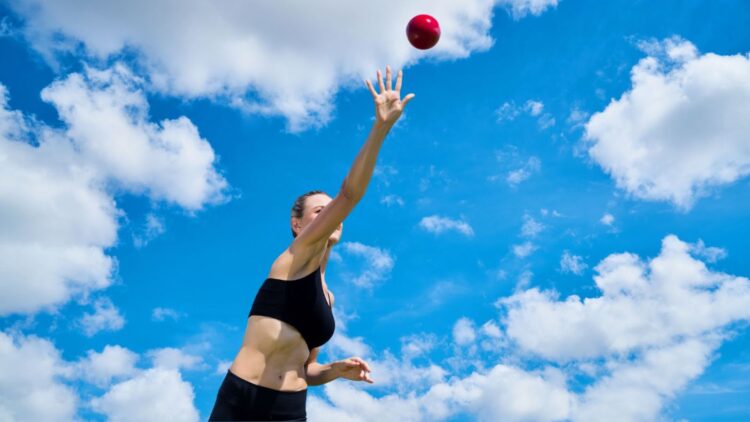
OBJECTIVE OF HEPTATHLON: Earn the most total points by competing in 7 different track and field events.
NUMBER OF PLAYERS: Not specified; usually 20+
MATERIALS: Athletic attire
TYPE OF GAME: Sport
AUDIENCE: 11+
OVERVIEW OF HEPTATHLON
A heptathlon is a two-day competition in which women athletes compete in a total of seven track and field events. Essentially the women’s version of the decathlon (which is generally only competed in by men), the winner of the heptathlon is often regarded as the “world’s fittest woman” because of the vastly different skillsets that are needed to rank highly in all of the seven competition events.
Historically, the roots of the heptathlon only trace back to the early 1980s when the new seven-event competition replaced the original pentathlon at the 1984 Summer Olympics. Since then, the heptathlon has remained largely unchanged and continues to be the premier combined women’s athletics competition despite efforts to push a women’s decathlon to the forefront.
The modern Heptathlon was inspired by the events of the ancient Greek Olympics. Events link the long jump, wrestling, and the discus throw were influential to the modern events.
A men’s heptathlon also exists, although its popularity pales in comparison to the decathlon. The men’s version of the heptathlon consists of a slightly altered slate of events, although all are still running events, throwing, and jumping events.
SETUP
EQUIPMENT
The only equipment necessary to compete in a heptathlon is athletic attire, such as that worn by any other track and field athlete. While certain events do require additional equipment (such as shot put, javelin, etc.), this is all provided by the competition organizers.
EVENTS

Women’s heptathlon consists of seven total events spread out across 2 days. These following events include:
Day 1:
- 100-Meter Hurdles – A short-distance sprint with numerous hurdles to jump over
- High Jump – Jump over a bar held high off the ground
- Shot Put – Throw a nearly nine-pound ball the farthest distance possible
- 200-Meter Sprint – A short-distance sprint
Day 2:
- Long Jump – With a running start, jump the farthest distance possible
- Javelin Throw – Throw a spear-like javelin as far as possible
- 800-Meter Run – A two-lap race around a track
Men’s heptathlon consists of similar events, although some are slightly different. Interestingly, the men’s heptathlon event is held indoors, while the women’s event is held outdoors.
Day 1:
- 60-Meter Sprint – A very short-distance sprint
- Long Jump – Same as the women’s event
- Shot Put – Uses a 16-pound ball
- High Jump – Same as the women’s event
Day 2:
- 60-Meter Hurdles – A very short sprint with a few hurdles to jump over
- Pole Vault – Essentially an extreme version of the high jump in which athletes use giant poles to propel themselves over bars held very high off the ground
- 1000-Meter Run – A two-and-a-half lap race around a track
GAMEPLAY

Heptathlon events utilize a unique heptathlon scoring system that is similar to the decathlon. As there are three different types of events in a heptathlon that utilize different performance benchmarks (distance, height, and time), a unique formula is used to translate an athlete’s performance in an event into points that are equally comparable with the performance and gain points in a different event.
For the most part, the scoring formula for each type of event is set so that 1,000 points is equivalent to an “elite” performance, while 0 points is basically a failed attempt. This means that between 0 and 1,000 points, every possible distance or time increment is assigned a specific points value, with points over 1,000 also being possible.
For context, the following are the benchmarks that must be hit in each event in the women’s heptathlon to award 1,000 points and 700 points:
1,000 Points:
- 100m Hurdles: 13.85 seconds
- High Jump: 1.82 meters
- Shot put: 17.07 meters
- 200m Sprint: 23.80 seconds
- Long Jump: 6.48 meters
- Javelin Throw: 57.18 meters
- 800m Run: 2:07:63 (2 minutes and 7 seconds)
700 Points:
- 100m Hurdles: 16.12 seconds
- High Jump: 1.57 meters
- Shot put: 12.58 meters
- 200m Sprint: 27.14 seconds
- Long Jump: 5.50 meters
- Javelin Throw: 41.68 meters
- 800m Run: 2:29:47 (2 minutes and 7 seconds)
To help with the scoring formula, use this calculator.
The heptathlon is one of the most thrilling Olympic events to watch, as athletes compete in various disciplines, showcasing their versatility across different track and field events. It requires a combination of speed, strength, agility, and endurance, making it both challenging and demanding.
Check out just how incredible these athletes are:
The THRILLING Highlights of the Women’s Heptathlon in Tokyo!
GREATEST HEPTATHLON PERFORMANCES
As previously mentioned, the winner of a heptathlon is often regarded as the “fittest woman in the world” because of the sharp contrast between the strength skills needed for the throwing events and the speed and agility skills needed for the running and jumping events. The following are the only four women to ever cross the 7,000-point barrier (1,000+ points in each event), making them some of the greatest female athletes in history and world records setters:
- 7,291 points – Jackie Joyner-Kersee (USA) (1988)
- 7,031 points – Carolina Klüft (SWE) (2007)
- 7,013 points – Nafissatou Thiam (BEL) (2017)
- 7,007 points – Larisa Nikitina (URS) (1989)
Jackie Joyner-Kersee still is the world record holder for the highest score.
END OF GAME
At the end of the second day of competition, the athlete with the highest combined point total from the seven events is the winner of the heptathlon.
- 30 GAMES TO PLAY OVER TEXT - April 22, 2024
- 20+ FREE PRINTABLE BABY SHOWER GAMES - April 16, 2024
- 20+ College Party Games for the Best Night Ever! - April 2, 2024